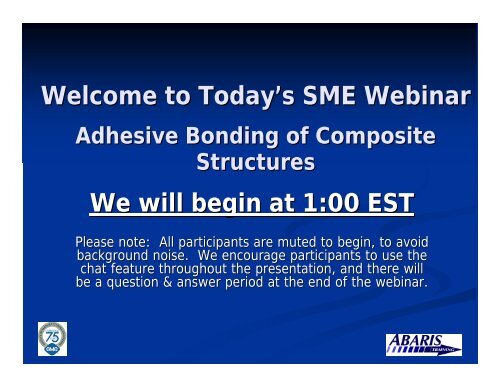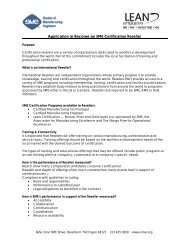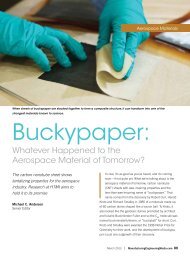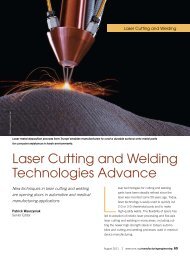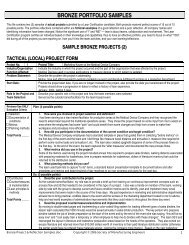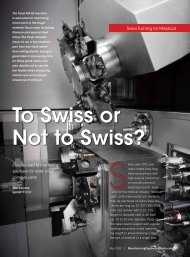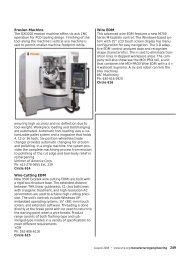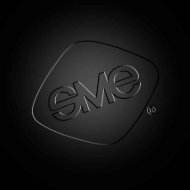Resulting Peel Ply Surfaces
Resulting Peel Ply Surfaces
Resulting Peel Ply Surfaces
- No tags were found...
Create successful ePaper yourself
Turn your PDF publications into a flip-book with our unique Google optimized e-Paper software.
Welcome to Today’s s SME WebinarAdhesive Bonding of CompositeStructuresWe will begin at 1:00 ESTPlease note: All participants are muted to begin, to avoidbackground noise. We encourage participants to use thechat feature throughout the presentation, and there willbe a question & answer period at the end of the webinar.
Adhesive Bonding ofComposite StructuresLouis C. DorworthDivision ManagerAbaris Direct ServicesAbaris Training Resources, IncReno, NVwww.abaris.comlou@abaris.com
Some Adhesively BondedComposite Structures
Bonding Definitions:• Co-curing: The act of curing a compositelaminate and simultaneously bonding it tosome other uncured material, or to a corematerial such as balsa, honeycomb, or foamcore• All resins & adhesives are cured during the sameprocess• Co-bonding: The curing together of two ormore elements, of which at least one is fullycured and at least one is uncured• Requires careful surface preparation of thepreviously- cured substrate• Additional adhesive may be required at interface
Bonding Definitions:• Secondary Bonding: The joining together, bythe process of adhesive bonding, two ormore pre-cured composite parts, duringwhich the only chemical or thermal reactionoccurring is the curing of the adhesive itself• Requires careful preparation of each previouslycured substrate at the bonding surfaces• Usually requires well designed fixturing to align &clamp parts during processing• Re-heating previously cured substrates can berisky
Loads on Bonded JointsBest Joint DesignsTensionCompressionShearCleavageBoth parts are rigid<strong>Peel</strong>One or both parts are flexible
Bond Failure Modes• Adhesive Failure: Failure of a bonded jointbetween the adhesive and the substrate• Primarily due to a lack of covalent activitybetween the adhesive and the substrate• Can be indicative of poor surface preparation• Or, incorrect adhesive selection for the substrateAdhesive comes clean from one surface or bothAdhesive Failure
Bond Failure Modes• Cohesive failure: Failure of an adhesive jointoccurring primarily in the adhesive layer• Optimum type of failure in an adhesive bonded jointwhen failure occurs at predicted loads• Lower failure loads are indicative of poorly cured adhesive ormoisture or other contaminants present in the adhesiveCohesive Failure
Bond Failure Modes• Substrate failure: Interlaminar fracture incomposite structures, usually between the firstand second plies adjacent to the bondlineSubstrate Failure
• EpoxiesStructural Adhesives• Wide range of high-strength epoxies availablewith a variety of curing & service temperatures• Most widely used adhesive in aerospace industry• Bismaleimide (BMI)• High temperature cure/service (up to 600°F)• Used in new generation fighter A/C (F-22, F-35) F• Cyanate Ester• Good dielectric properties• Low Coefficient of Thermal Expansion (C.T.E.)
Structural Adhesives• Modified Acrylics/Methacrylates• High strength and good elongation properties• Bonds to Thermoplastics!• Polyurethanes• Tough/abrasion resistant• Good low-temperature adhesion properties• Silicones• Useful for bonding to glass, plastics, & other rubbers
• Liquids:Liquids, Pastes, & FilmAdhesives• Viscosities typically range between 100-6000 cP• Generally work best in thinner bondlines and providefor a higher degree of direct load transfer than pastes• Effective thickness range: .002-.010 inch• Can run out of thicker gaps if viscosity is too low• Liquids tend to be more brittle and less resistant topeel and cleavage loads than pastes or films• Often “liquid” adhesives are categorized as “pastes”without distinction by the various adhesivemanufacturers
• PastesLiquids, Pastes, & FilmAdhesives• Paste adhesive viscosities typically are > 10,000 cP• Generally works better in slightly thicker bondlines• Effective thickness range: .005-.020 inch• Thicker shim or gap filling applications are not necessarilyconsidered structural – Typically shimmed & fastened• Different fillers offer a wide range of properties• Minerals, rubbers, thermoplastics, & metals are common• Pastes usually do not wet-out as well on the substrateas liquids due to the influence of the added filler
Liquids, Pastes, & Film• Film AdhesivesAdhesives• High-performance structural prepreg film adhesives• Stored frozen & thawed to room temperature before use• Requires an elevated temperature cure cycle• Different carriers for maintaining B/L thickness control• Woven scrim cloth• Knit carrier• Non-woven (mat)• Typically carriers are made of treated Polyester or Nylon fibers
Carriers Used w/Film & Paste AdhesivesScrim CarrierKnit CarrierNon-Woven Mat
Reticulation• Reticulating film adhesives• Bonding to honeycomb core• Heating an unsupported or knit supported film adhesive,causing the adhesive to flow and fillet the core cell ends• Reticulating perforated skins in acoustic panels• Heating an unsupported film adhesive, causing the adhesiveto flow away from the small holes in the acoustic skin priorto bonding it to a honeycomb or other open cell corematerial
Bonding to Honeycomb CoreAdhesive fillet atcore cell walls
Bonding to Foam CoreAdhesive attaches toporous foam surfaceFailure occurs along the “zip-line”in the weaker foam core surface
• Goal:Surface Preparation ofThermoset Composites• Raise the surface-free free energy of the compositesubstrate to enhance wetting of the surface and tofacilitate molecular cross-linking• Raise surface energy without damaging fibers in the laminate• *Ref: Armstrong & Allen; Surface Tension/Surface Energy• Methods:• ScotchBrite or sandpaper abrasion• Grit-blast with alumina, silica, or other abrasive media• High risk method - somewhat operator dependent
What about <strong>Peel</strong>-<strong>Ply</strong> <strong>Ply</strong> <strong>Surfaces</strong>?Ref.: DOT/FAA/AR-06/28, The Effect of <strong>Peel</strong> <strong>Ply</strong> Surface Preparation Variables on Bond Quality• Un-coated Nylon or polyester fabrics• Can leave minor trace contaminates on surface• Heavy fabrics do not always peel-off easily• Release treated Nylon or polyester fabrics• Can transfer release agent to part surface• P.T.F.E. Coated Glass Fabrics• Easy to remove from part surface with low risk ofdamage to part• Use of PTFE results in a fairly low-energy surfaceon the composite panel surface
What about <strong>Peel</strong>-<strong>Ply</strong> <strong>Ply</strong> <strong>Surfaces</strong>?• Pros:• <strong>Peel</strong> ply surfaces tend to be consistent• Low-risk of contamination w / proper peel ply• Cons:Ref.: DOT/FAA/AR-06/28, The Effect of <strong>Peel</strong> <strong>Ply</strong> Surface Preparation Variables on Bond Quality• <strong>Peel</strong> ply only typically results in lower surface freeenergy than peel ply plus abrasion methods• The use of improper peel ply can dramaticallychange the bond-surface characteristics
<strong>Resulting</strong> <strong>Peel</strong> <strong>Ply</strong> <strong>Surfaces</strong>Ref: Hart-Smith, The Curse of the Nylon <strong>Peel</strong> <strong>Ply</strong>, SAMPE proceedings March 1996The heavier the peel ply fabric the more pronounced the problem:Resin Matrix<strong>Peel</strong> <strong>Ply</strong> FabricCross-section section through peel ply on surface of laminate
<strong>Resulting</strong> <strong>Peel</strong> <strong>Ply</strong> <strong>Surfaces</strong>Ref: Hart-Smith, The Curse of the Nylon <strong>Peel</strong> <strong>Ply</strong>Remove the peel ply from the surface
<strong>Resulting</strong> <strong>Peel</strong> <strong>Ply</strong> <strong>Surfaces</strong>Ref: Hart-Smith, The Curse of the Nylon <strong>Peel</strong> <strong>Ply</strong><strong>Peel</strong> ply leaves smallfractured peaks of resinon the surfaceWould you want to bond to this surface?
Surface Free-Energy ExchangeIf the surface tension value of the liquid isgreater than the surface-free free energy value ofthe substrate the liquid molecules stay boundtogetherPoor wetting means a poor bond!
Surface Free-Energy ExchangeWhen the surface free energy value of thesubstrate is higher than that of the liquid itallows the liquid to uniformly wet the surfaceThis is important to achieving a good bond
Surface Preparation ofThermoplastic Composites
Cleaning the Freshly EnergizedComposite Surface• Objective: Remove dust and debris from bonding surfacewithout inducing contamination• Legacy Method:• Solvent wipe with clean, approved wipes• Double wipe method is often specified: Use a solvent saturatedwipe followed with a clean dry wipe to pick-up residualcontaminants• High risk of inducing moisture or other contaminants ontofreshly energized/slightly porous composite surface
Cleaning the Freshly EnergizedComposite Surface• Question: What effect does wiping with solvent have onthe surface-free free energy of the freshly preparedcomposite surface?• Alternative Method• Dry wipe with clean, approved wipes• Multiple wipes may be required to remove dust sufficiently• Low risk of inducing moisture or other contaminants
Adhesive Application• Applying Film Adhesives• Simple to apply along the faying surface of one ofthe substrates to be bonded• Heat may be required to form some films to complexshapes• Applying Liquid & Paste Adhesives• Goal: to apply slightly more adhesive thanrequired and close the joint in a timely fashion• Provide enough adhesive along the joint to do the job• See the application template design sketch (next slide)• Excess adhesive = excess weight
Using an ApplicationTemplateTemplateAdhesivePrepared Part
Thermoplastic Dual AdhesiveApproach to BondingLocal heating to melt film but not substratesCarbon/PEEK laminateLower melting point PEI filmco-molded with CFRPAdditional PEI layer
Open Time is the EnemyRef.: Henkle/Loctite Hysol EA 9394 Open-Time Considerations document• A freshly energized surface will try to stabilizeover time and subsequently lose the desiredeffect• The surface also takes on moisture and other low-energy contaminants when left exposed to the normalshop/clean-room environment• Amine-cured epoxy adhesive left open on thesurface for extended time may also be affectedby the environment (H 2 O & CO 2 )• Amine Carbonate formation can inhibit most room-temperature curing epoxy adhesive systems
Bondline Thickness Control• Consistent bondline thickness of the adhesivelayer is critical, without uniform thickness thejoint is only as strong as its weakest point• Options for thickness control media:• Micro-Beads (mixed in the adhesive)• Scrim Cloth• Knit Carriers• Non-Woven Carriers (Mat)
Bondline Thickness ControlPrecise .005 inch Diameter Micro-beads
Bondline Thickness ControlResults in increasedcleavage load applied atedge of jointUnequal stress distribution through an unevenly bonded joint
Uniform Clamping Pressure• Uniform clamping pressure is required toachieve good wet-out and optimum bondstrength• Added force contributes to free-energy energy exchange• Typical bonding pressures range from 5-50psi550psi• Mechanical clamping requires sturdy fixturing• Vacuum bagging can provide uniform pressure• Vacuum bagging can also contribute to micro-porosity orvoids in the joint due to rapid degassing or “frothing” ofthe adhesive under vacuum
Curing the Adhesive• To achieve maximum performance andultimate structural & thermal properties, theadhesive must be properly cured and/or post-cured• Room temperature curing systems usually takeseveral days to achieve good structural properties• The ISO definition of “room temperature” is 77° F(25°C)• Elevated temperatures lower the adhesiveviscosity, enhancing wet-out characteristics andresult in a faster cure time
Effect of Different Fiber Forms at theFaying <strong>Surfaces</strong> in a Bonded Joint• Uni-directional Tape• Should run directly across the joint for best results• Normally not recommended as faying layer in joint design• Bi-directional woven fabrics• Plain & Twill weaves• Generally good surface materials for faying layer in joint design• Harness-satin satin weaves• Warp/fill face orientation dominance must be considered• Multi-axial stitched fabrics• Functions like a unidirectional tape dependent on faying layerorientation• Non-woven mats• Diminished load transfer through mat surface layer
Effect of Different Fiber Forms at theFaying <strong>Surfaces</strong> in a Bonded JointUni-directional fibers at faying surfaces:Orient fibers across the bonded joint in primary load direction
Effect of Different Fiber Forms at theFaying <strong>Surfaces</strong> in a Bonded Joint90° Fibers tend to “roll” off ofthe underlying ply of thesubstrateEffect of 90° uni-directional fibers at bond joint
Effect of Different Fiber Forms at theFaying <strong>Surfaces</strong> in a Bonded JointBi-directional plain-woven fabrics at faying surfacesprovide uniform load transfer across bonded joint
SummaryApply uniform clamping pressure5-50 psiProperly preparesubstrate surfacesControl the bondlinethicknessCorrectly mix and/orapply adhesiveProperly cure theadhesive
Thank You for Attending Today’sWebinar!Questions? Comments?• You can contact Lou Dorworth at: lou@abaris.com or byphone at: (775) 827-6598 X-228X• Today’s s presentation will be posted on the SME CompositesManufacturing Tech Group webpage (www.sme.org/cma).We will send you an email once the presentation is posted.• This webinar was brought to you and made possible by the SMEComposites Manufacturing Tech Group. If you are interested inbecoming active in this group, please emailtechcommunities@sme.orgMark your calendar! The SME “Composites Manufacturing”Event is April 14 – 16, 2008 in Salt Lake City, UT.Visit www.sme.org/composites for more information!*Plus* the SME “Tooling for Composites” event is comingFall 2008. For more information, contact KMennillo@sme.org


